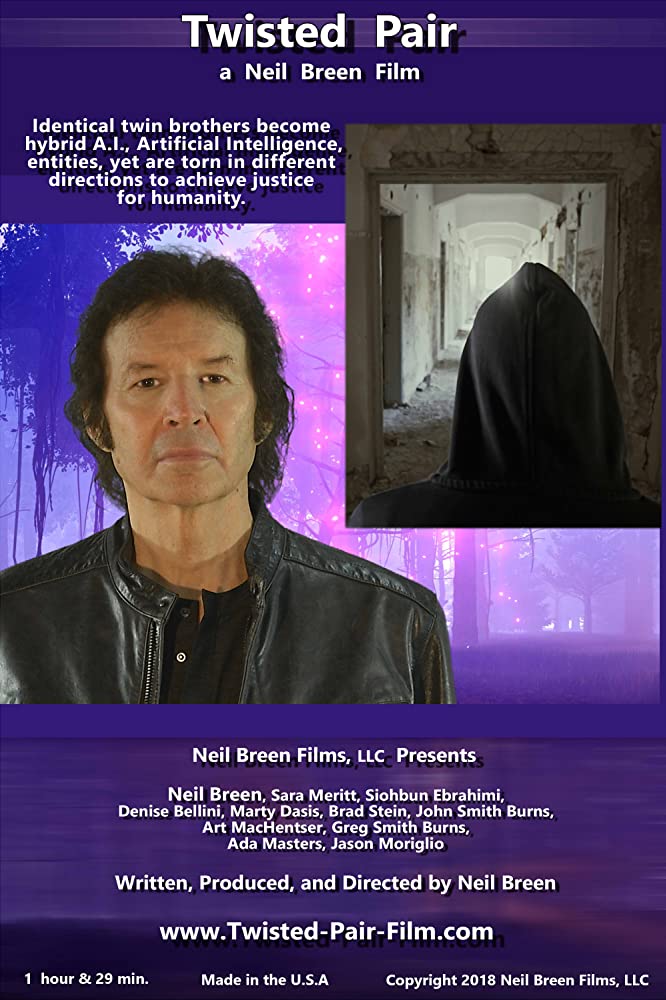
What came first, the stock footage, or the script? That is the question I repeatedly asked myself after sitting through Neil Breen’s fifth film, Twisted Pair, now finally available in digital formats.
An aside about availability: Breen’s movies could up until recently only be purchased on DVDs from the auteur’s website. For a mere $30, he would send you a DVD packed in a brown cardboard envelope, burned straight from his computer. Cover? Neil Breen does not need covers.
But I digress.
Twisted Pair is every bit as baffling as Tommy Wiseau’s The Room, which in comparison seems downright coherent. Breen kicks his film off with five minutes of stock footage, sometimes with himself superimposed (yes, he wrote, directed, starred, and catered Twisted Pair) delivering a river of nonsensical exposition. He is a twin, we are told over footage of kids straight from a suntan lotion commercial, and at some point… Well, something happened. Precisely what is hard to say, but it sounds like some higher being brought Cade and Cale to the heavens and bestowed upon them powers to… fight evil? Maybe? Cale at least wasn’t particularly good at it, so his powers were rescinded while Cade started a fruitful career in law enforcement(?). As logic would dictate, Cale turned into an evil junkie. Something like that.
I don’t even know where to start describing the actual movie. Twisted Pair consists conservatively of forty-five minutes of stock footage, and the film was seemingly written around it. Breen uses it all in, shall we say, creative
manners. An example is a scene where he leads soldiers through a building, running from the back of the group to the front of it. Thing is, his superimposed self is not layered and is therefore always positioned on top of the footage all the way through. 3D it is not in any sense of the word.
There is a scene that is supposed to be a cute relationship joke(?), where Cade assaults a woman he has stalked, screaming obscenities at her, and getting a painting smashed over his head. Just as he is quite literally about to kill her, he quips, what’s for dinner
, and they both share a good laugh. They’re a couple. That scene goes on for three minutes.
The rest of the film largely takes place in two locations: what I presume to be Neil Breen’s home (judging by the fact it has been used in a number of previous movies) and an office park where he likely was not allowed to film inside the offices. Anything put to reel is either in the hallways or in the courtyard. I’m actually not even sure if they were allowed inside the buildings at all, and what was filmed was during a break-in. Somewhat hilariously, when Cade takes his belle to a restaurant
where he has reserved all the tables
, it’s painfully clear they are sitting in the office park’s smoking area.
It’s bizarre. It all is. Breen portrays a superhero secret agent, yet has clearly never gone for even a light jog in his life. It is even weirder looking when his jeans are pulled up ten inches past his waist, with his Henley shirt tucked in.
The stock music, while good, never fits the scenes, even in the literal sense. When a scene ends, the sound gets chopped off, mid-note. I seriously doubt any of the movie used anything other than natural light, and characters are sometimes only halfway in frame. Roughly half the shots are out of focus.
And Breen playing twins? Let’s just leave it with this green screen magic…

In that sense, there is nothing right about Twisted Pair. Yet… I can’t take my eyes off it. It is so utterly fascinating that somebody deemed this movie releasable. (That was Breen, by the way, who also served as the distributor.) It’s like a psychological study of a man with delusions of grandeur. Even more baffling, I don’t think that’s actually the case. While Breen does seem like a guy with misplaced self-confidence, he also appears quite affable in interviews.
Twisted Pair is not a good movie, yet worth every cent sent iTunes or Amazon’s way.
Sequel alert!
Cade Altair
will return threatens the end-credits. Breen is currently shopping the film around, having sworn off self-financing.
Podcast recommendation
How Did This Get Made recently did a hilarious live episode on Breen’s magnum opus, Fateful Findings.


